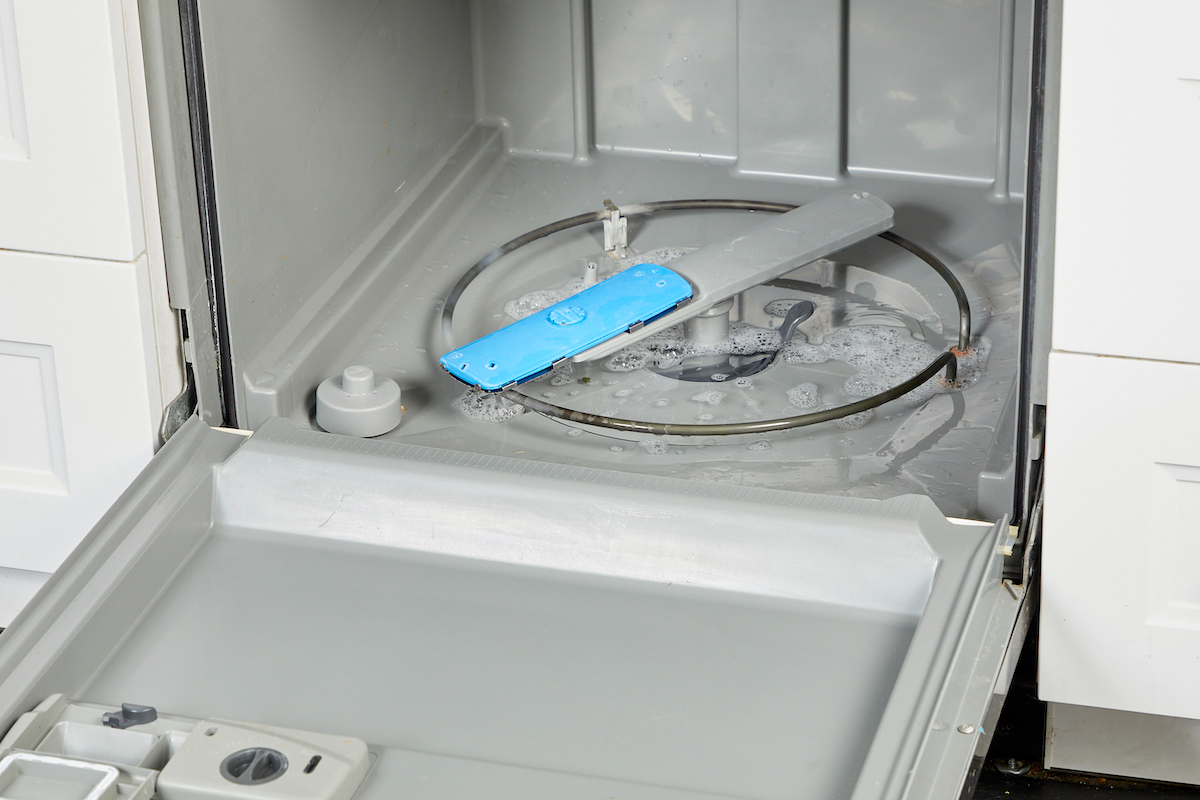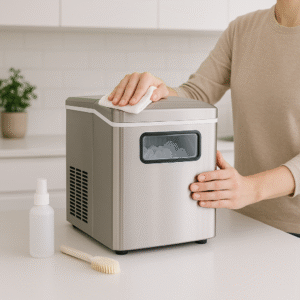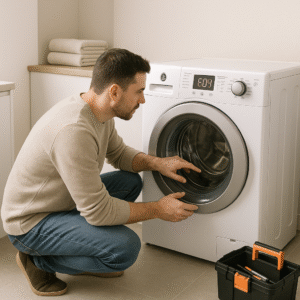A dishwasher that won’t drain can be a frustrating problem. You open the door, and there it is—standing water at the bottom. This common issue can leave you wondering, “Why is there standing water in my dishwasher?”
Table of Contents
ToggleUnderstanding the root cause of Dishwasher Not Draining is the first step to fixing it. Whether it’s a clogged drain hose or a faulty pump, identifying the problem is crucial.
In this guide, we’ll walk you through the process of troubleshooting your dishwasher drain issues. You’ll learn how to unclog a dishwasher drain hose and more.
By following these steps, you can save time and avoid costly repairs. Let’s dive into the solutions and get your dishwasher back to working order.
Why Is There Standing Water in My Dishwasher?
Standing water in your dishwasher can be more than inconvenient. It can also indicate a bigger problem. Several issues could cause water to remain in the bottom after a cycle.
One common cause is a clogged filter. Food particles and debris can block the filter, preventing proper drainage. Another possibility is a kinked or clogged drain hose, which restricts water flow out of the dishwasher.
Besides these, a malfunctioning drain pump could be the culprit. Pumps can wear out over time or get obstructed, leading to drainage issues.
Here are some potential reasons for standing water:
- Clogged filter or drain hose
- Faulty or blocked drain pump
- Incorrectly installed drain hose or air gap
Recognizing these signs is crucial to resolving the drainage problem. By addressing these underlying causes, you can effectively troubleshoot and fix the issue.
Garbage Disposal Not Working? How to Fix a Jammed or Humming Disposal in Simple Steps
Common Causes of Dishwasher Not Draining Problems
Dishwasher drain problems arise from various issues. Identifying these causes is essential to fixing them efficiently.
One typical issue is a clogged drain, often due to food debris or mineral buildup. Such blockages can severely impede water flow, causing drainage failures.
Incorrect installation of the drain hose, such as kinks or improper placement, can restrict water exit. This can lead to water backup during the dishwasher cycle.
Malfunctioning parts also contribute to drainage issues. For instance, a faulty float switch may disrupt water level control, while a problematic drain pump can prevent water from leaving the machine.
Common causes include:
- Clogged drains due to debris or buildup
- Improper drain hose installation
- Faulty float switch or drain pump
Addressing these problems usually resolves drainage issues. Understanding and diagnosing the root of the problem is the first step in ensuring your dishwasher operates smoothly again.
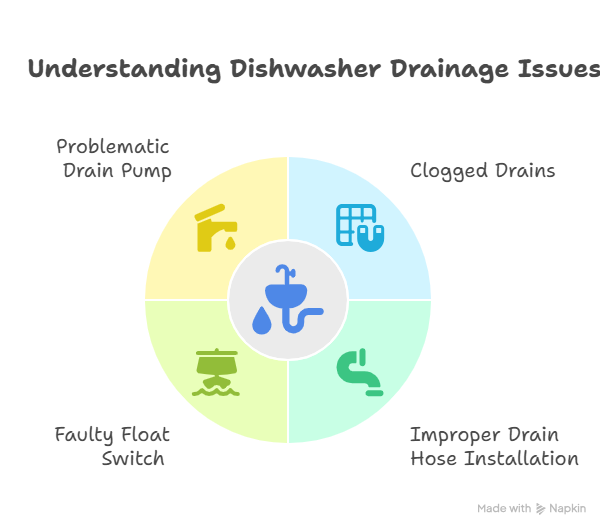
Safety First: Preparing to Troubleshoot
Before beginning any dishwasher repair, safety is paramount. Always unplug the dishwasher from the power source to prevent electrical shock.
To ensure a safe workspace, gather necessary tools like gloves and a towel. This preparation minimizes potential hazards during troubleshooting.
Here’s what to remember:
- Unplug the dishwasher to eliminate electrical risks.
- Wear gloves to protect hands from sharp parts.
- Keep a towel handy to manage any water spills.
By prioritizing safety, you can focus on resolving the dishwasher’s drainage problems effectively and confidently.
Step 1: Remove Standing Water from the Dishwasher
Before addressing the drain problem, eliminate any standing water. This step makes further inspection simpler and less messy.
Begin by using towels or a sponge to soak up the water. An alternative method is using a small cup or bowl to scoop it out.
Here’s how to proceed:
- Use towels or a sponge for absorption.
- Optionally, scoop water out with a small cup.
- Ensure the interior is as dry as possible.
Having a dry dishwasher allows you to inspect and work on internal components without obstruction from residual water.
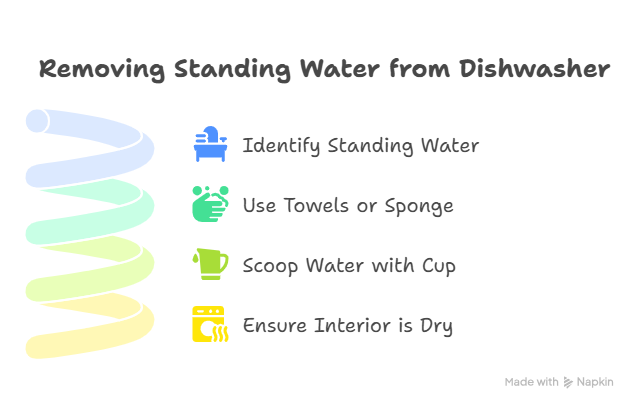
Step 2: Check and Clean the Dishwasher Filter
The dishwasher filter plays a vital role in catching food particles. Over time, it becomes clogged, affecting drainage.
Start by locating the filter at the bottom of your dishwasher. Check your manual if you’re unsure of its position.
Here’s what you need to do:
- Remove the lower rack for easier access.
- Twist or lift the filter gently to remove it.
- Rinse under warm water to remove grime.
A clogged filter not only prevents proper drainage but can also lead to odors. Regular cleaning can reduce this risk.
If necessary, use a soft brush to scrub away stubborn residue. Proper filter maintenance aids in better dishwasher performance and a cleaner wash.
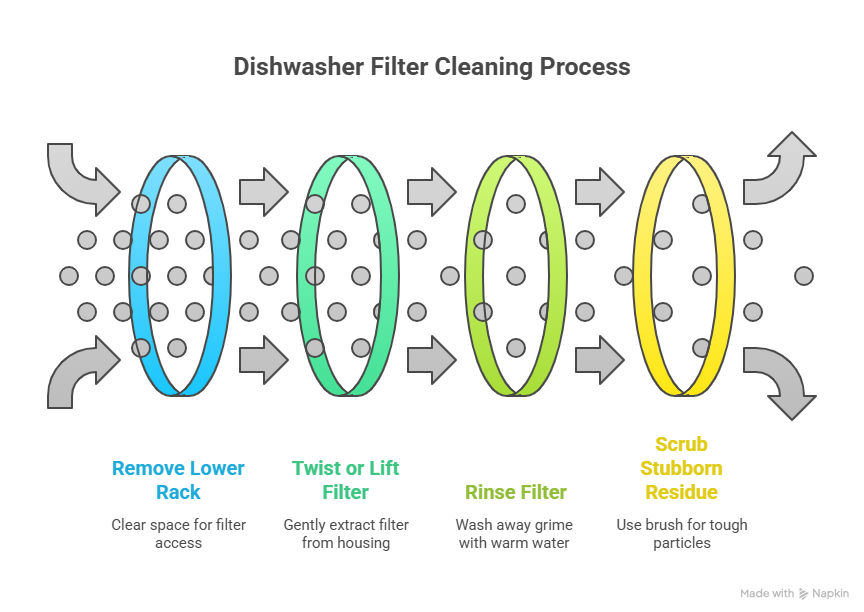
Step 3: Inspect and Unclog the Drain Hose
A clogged drain hose can halt the dishwasher’s drainage. Often, this hose can become obstructed by debris.
First, ensure the dishwasher is unplugged for safety. Then, locate the drain hose, usually connected to the sink or disposal.
To inspect and unclog the hose, follow these steps:
- Detach the hose from both the dishwasher and the sink or disposal.
- Check for any visible blockages.
- Use a long, flexible brush to dislodge and remove debris.
A mixture of baking soda and vinegar can be useful. Pour this through the hose to break down stubborn clogs.
Make sure the hose isn’t twisted or kinked, as this can impede water flow. Reattach it securely once clear. Regular maintenance of the drain hose helps ensure smooth operation and effective water drainage.
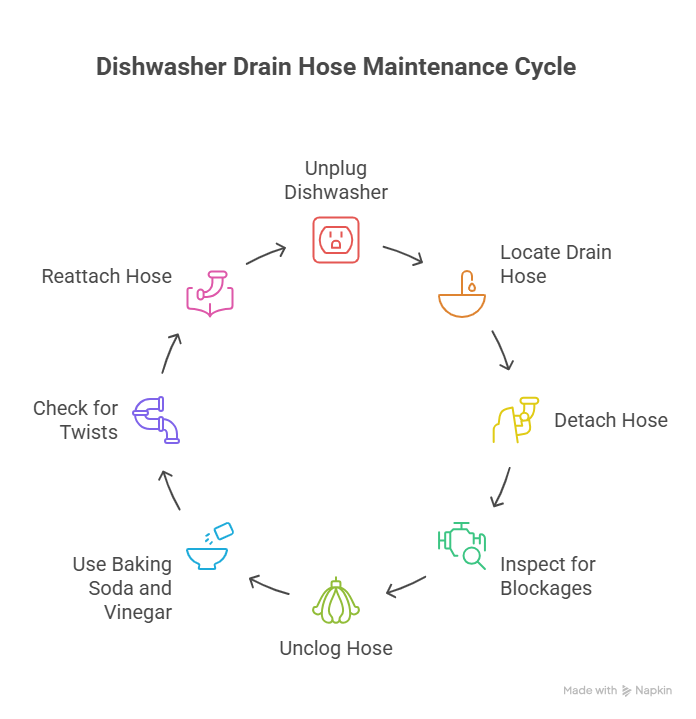
Step 4: Examine the Garbage Disposal and Air Gap
If your dishwasher connects to a garbage disposal, check it first. A clogged disposal can block the dishwasher’s drain path.
Make sure the disposal is clean and functioning properly. Run water and the disposal unit for a few seconds to clear any debris.
Next, inspect the air gap, which prevents backflow. This small device is usually on the sink or counter.
To check the air gap, follow these steps:
- Remove the cap and examine inside for debris.
- Use a toothpick or tweezers to clear any blockage.
- Ensure the hoses attached are secure and debris-free.
Both the garbage disposal and air gap must be in good condition. They are crucial to maintaining proper dishwasher drainage. Regular inspections prevent many issues and keep the system working smoothly.
How to Unclog Garbage Disposal: Step-by-Step Guide & Tips
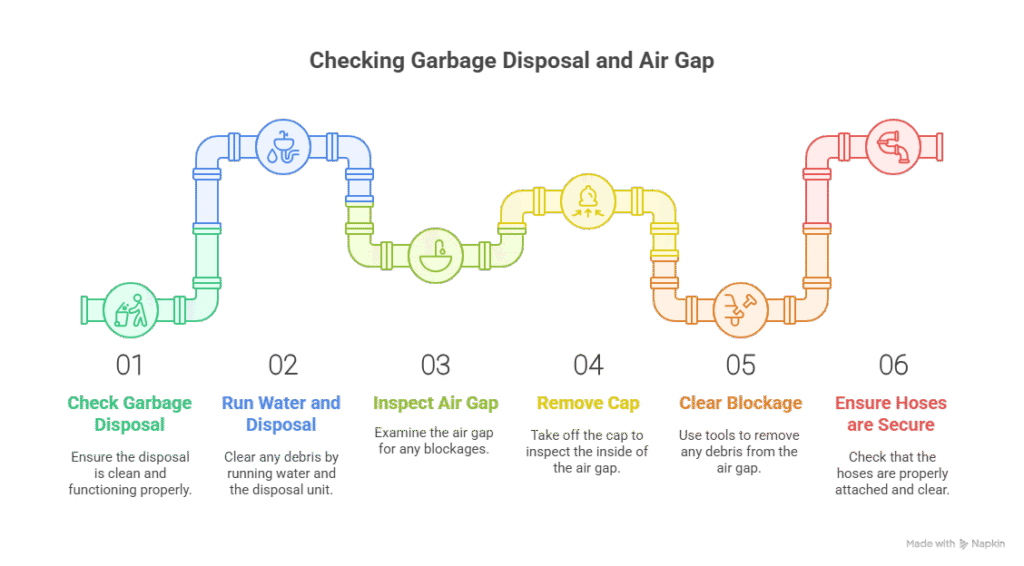
Step 5: Check the Drain Pump and Valve
The drain pump pushes out water from your dishwasher. If faulty, it hinders drainage.
First, locate the drain pump under the dishwasher unit. Listen for unusual noises during a cycle, which might indicate a problem.
If you suspect an issue, follow these steps:
- Cut off the power supply for safety.
- Remove the pump cover and visually inspect for blockages.
- Spin the impeller manually to check for obstructions.
Next, examine the drain valve. It should open and close smoothly. A stiff or malfunctioning valve can restrict water flow.
Regular maintenance of these components helps keep your dishwasher running efficiently. Keeping them clear avoids many common drainage problems.
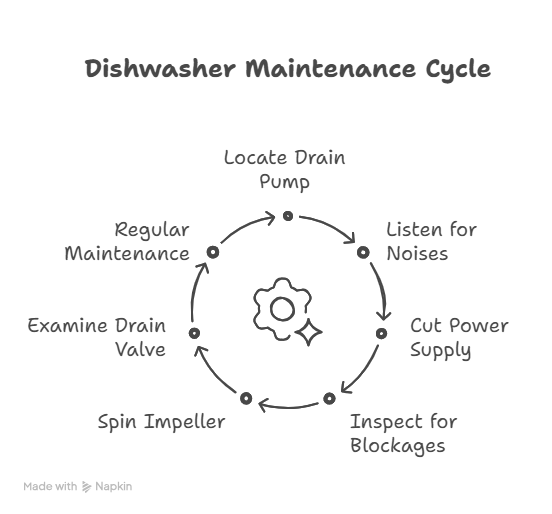
Step 6: Test the Float Switch and Door Latch
The float switch regulates water levels in the dishwasher. A malfunction here can cause drainage issues.
First, locate the float inside the dishwasher, which is often beneath the bottom rack. Gently lift it, then let it drop back into place. It should move freely.
Next, examine the door latch. A secure latch ensures the dishwasher operates correctly. If it’s loose, the cycle might not complete, causing water to remain.
To maintain these parts:
- Ensure the float moves without friction.
- Tighten the latch if it’s loose.
- Replace components if visibly damaged.
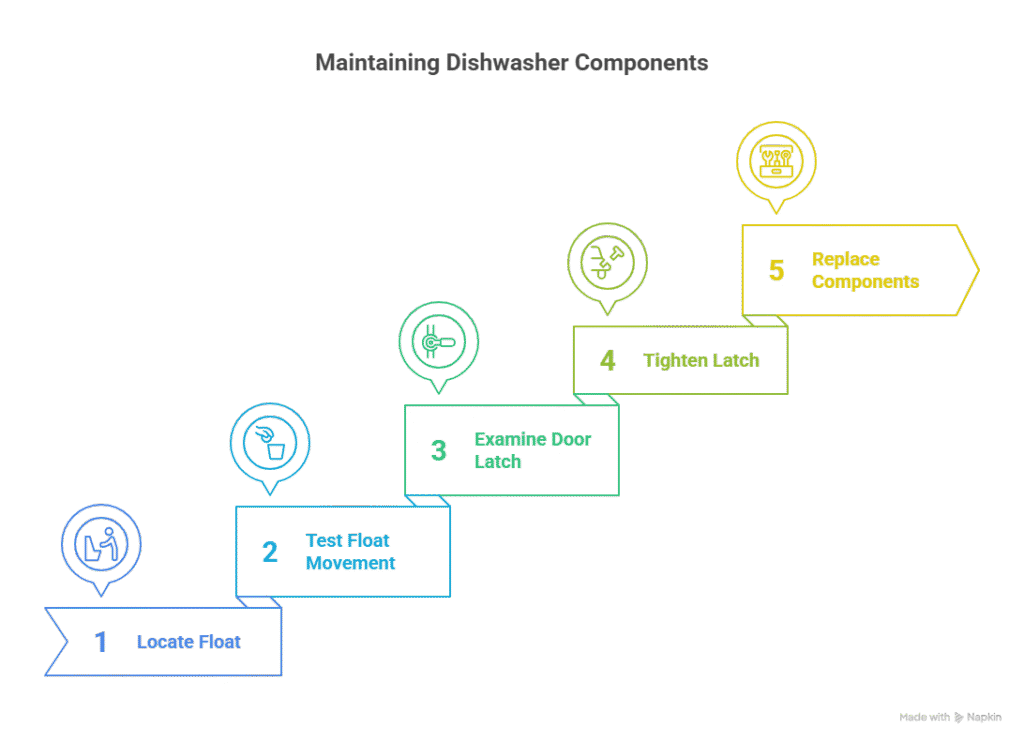
Step 7: Run a Cleaning Cycle and Use Dishwasher Unclogger
Running a cleaning cycle can help clear minor blockages. Use a dishwasher-safe cleaner to dissolve any mineral deposits.
Begin by placing the cleaner on the bottom of the dishwasher. Run a hot water cycle to let the cleaner work its magic.
For stubborn clogs, a dishwasher unclogger might be necessary. Follow the instructions for safe use:
- Pour the product into the bottom drain area.
- Allow it to sit for the recommended time.
- Rinse thoroughly with another hot water cycle for best results.
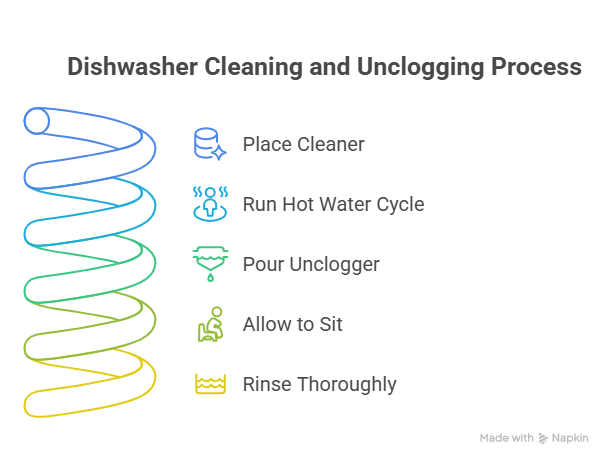
Step 8: When to Call a Professional
Some dishwasher issues require professional assistance. If you have tried all the steps and the problem persists, it’s time to call in the experts. Persistent drainage issues can indicate serious problems that need a professional’s touch.
Consider calling a professional if:
- The drain pump or valve replacement is needed.
- Electrical faults are detected.
- You’ve observed damage to crucial components.
Experts can diagnose issues accurately and offer solutions effectively.
Preventing Future Dishwasher Drain Issues
Preventive maintenance can save time and money. Regular care ensures your dishwasher runs smoothly without unexpected breakdowns. Follow simple steps to prevent future drain issues.
For effective prevention:
- Clean the filter monthly.
- Inspect the drain hose for kinks.
- Run hot water before each cycle.
These practices minimize clogs and enhance efficiency. Keep an eye on water levels and cycle performance as well. Early detection of anomalies helps in addressing potential problems quickly. By maintaining your dishwasher, you ensure its longevity and avoid costly repairs.
Frequently Asked Questions About Dishwasher Drainage
Many homeowners face issues with dishwasher drainage. Understanding these concerns can help in better maintenance. Here are common questions we often hear.
Why is there standing water in my dishwasher?
Standing water often points to a blockage. Inspect and clear the filter and drain hose.
How can I prevent clogs?
Regular cleaning is key. Check the filter and run hot water frequently to avoid buildup.
When should I call a professional?
If home remedies fail or there’s a persistent problem, consider expert help to prevent further damage.
Conclusion: Keep Your Dishwasher Running Smoothly
Maintaining your dishwasher can seem challenging, but it’s essential for seamless performance. Regular checks and cleanings not only prevent clogs but also extend the appliance’s life.
By following these steps, you can minimize disruptions and ensure your dishwasher runs efficiently. If problems persist, don’t hesitate to seek professional assistance. With proper care, your dishwasher will continue to serve you well for years to come.

